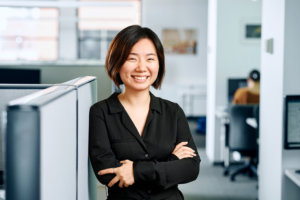Explore workplace lighting with David Seok, IALD and Xingying Peng, IES EP, Jr. Associate IALD. David and Xingying discuss how changing workplace trends, coworking, technology and other factors are influencing workplace lighting.
David and Xingying, what makes designing for the workplace different than other environments?
David: Out of all the market sectors, I’ve always enjoyed corporate lighting design. It just feels so relevant. So many of us spend so much time at the office, including myself. With workplace lighting, we want the design to be uniform, comfortable, and not distracting. People come to the office to be productive, so the lighting design should support that. While I’m designing a project, I often ask, “How would I feel working here?”.
Xingying: I enjoy challenging the stereotype about workplace design. Offices are known to be boring, but we can be very creative within the corporate environment. As designers, we can create moments of fun and identity in the workplace. It’s exciting to see a shift in what workplace design can be.
The workplace has changed significantly over the years. Can you tell us about your current strategy for workplace lighting?
D: Our strategy has been impacted by the changing nature of the work environment itself. Thirty years ago, everyone was sitting in cubicles with very general lighting. In each cubicle, there might be dedicated task lighting, but even up until a few years ago, we saw very general illumination. Now, the workplace is becoming more flexible, with spaces changing to accommodate different uses such as collaboration, heads down/focused work, private conversation, or lounges.
In the last five years, we’ve seen these flexible workplaces becoming more like hospitality spaces, especially with the rise of behemoth tech companies. We have started to ask, “How do you make the workplace not feel like the workplace?” Now we focus on creating special moments at the office, breaking away from the monotony and designing spaces that are attractive without being distracting.
X: Lately, the lighting has become more of a branded element of the business, representative of a company’s culture and style. Our clients really want the lighting to showcase their brand. So, we’re starting to introduce a lot of customization. We might work with a manufacturer to apply a signature color or include a special material that makes a statement. At the same time, we work to blend lighting into the space without being distracting.
What are some influences on workplace lighting design today?
D: There have been a lot of changes to energy conservation codes and requirements related to controllability. Many of the LEED and WELL points align with best practices in lighting design. Having individual control – task lights for at each desk, for example – allows people to adjust light levels to their needs and comfort. Meanwhile, occupancy sensors and vacancy sensors help to reduce energy usage by turning on the light only when spaces are occupied.
We find ways to make a space feel bright without expending too much energy. Sometimes that means providing uplighting on the walls or vertical illumination to make a space feel more balanced.
X: I’m always impressed when a decorative fixture looks beautiful and has a robust enough output. Especially in flex work areas, the clients often want something very decorative, but we want to make sure that it’s bright enough so that we don’t need supplemental lighting. When you find a fixture that checks all the boxes and looks great, it makes it very easy. More manufacturers are recognizing that need and putting design at the forefront.
Are there any other changes that impact your lighting design strategy?
D: Another significant impact to the workplace is the emergence of work-sharing companies like WeWork, Convene or Mindspace. It really changes the traditional office landscape of multi-year leases with tenants investing in a long-term space. Work-sharing has given companies flexibility on their space, as well as a built-in network of offices that employees can use as they travel. We are seeing the strength of companies that offer that kind of flexibility for their employees.
In a work-sharing environment, it is important to emphasize the character of common amenity areas. What we may also see happen is clients wanting more flexibility in installed overhead lighting, leading us to propose more wireless systems that can easily be programmed into different schemes, offering lots of flexibility.
Can you name some examples of impactful workplace lighting design?
D: We recently worked on TD Bank One Vanderbilt in New York City. This project is a great example of how the workplace is changing and incorporating different types of spaces. TD Bank has four floors of office space, mostly open office with neutral, comfortable lighting. The designer, Perkins Eastman, had a really clever concept of creating specialized lounges in the corner of each floor based on different elements of New York City, such as Chelsea, Bryant Park, or the Empire State Building. We customized the lighting design to highlight these special moments. The result is a series of custom reprieves that give each floor its own unique characteristics and offer a break from being in the workplace without leaving the office.
We also worked with a (confidential) tech company, which gave us an opportunity to really showcase their branding and make the workplace more enjoyable. They wanted their workplace to reflect what a cool, hip, fun company they are. We had a lot of opportunities to provide decorative elements that wouldn’t typically be in an office space, paying more attention to details and smaller intricacies that made each space within the office feel unique. We took an approach more common in hospitality than a traditional office project.
Do you have any predictions about future trends in workplace lighting?
D: Flexibility has become the name of the game. We’ll continue to see the strength of companies that offer flexibility to their employees to work from home or work from various cities. The influence of hospitality on workplace lighting and the prominence of decorative lighting is another major trend. I’ve been turning to decorative fixtures much more than a few years ago.
We’re also seeing technology and IoT becoming more accessible to consumers, so I predict we’ll start to see clients and business owners asking for the same thing in the corporate world. As technology like Philips Hue advances and becomes more accessible, we’ll see that becoming more widespread.
X: We’ll start to see light and health become more incorporated into the workplace. COVID has brought about awareness of disinfecting lights, and while those are controversial for environments outside of healthcare, I think we’re more aware of the role light can play in our health. We’re more aware of circadian lighting and how light affects us throughout the day. I think we’ll start to explore different color temperatures in the workplace.
We are also seeing more individual controllability at each workstation. As technology advances, like David mentioned, smart lighting will become more widespread at the workspace.











